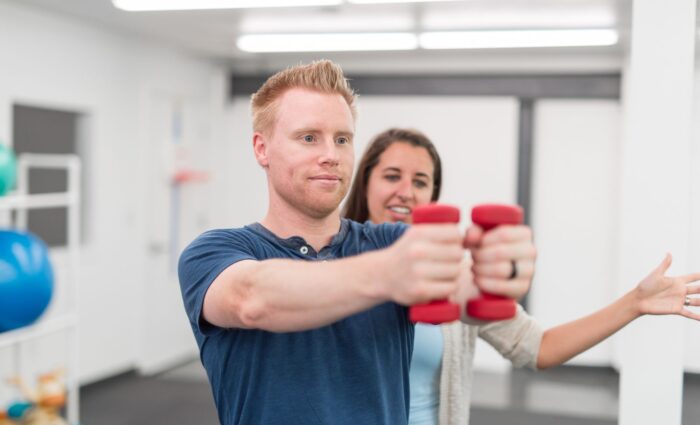A Physical Therapist Assistant (PTA) plays a critical role in the rehabilitation process. They work under the supervision of a physical therapist to help patients regain mobility, strength, and function after injury, surgery, or illness. But what does a physical therapist assistant do exactly? PTAs assist in a variety of settings, including outpatient clinics, hospitals, and rehabilitation centers. They carry out treatment plans, interact with patients, and monitor progress throughout the rehabilitation process.
At Rego Park Diagnostic & Treatment Center, PTAs are an integral part of the multidisciplinary team, helping patients in need of physical therapy or occupational therapy services. If you’re considering a career in healthcare or wondering about the job outlook for a PTA role, this guide will provide the answers. Additionally, this post will highlight how PTAs work in our Physical Therapy services to improve patient outcomes.
What is a Physical Therapy Assistant?
A Physical Therapist Assistant (PTA) is a licensed healthcare professional who works under the supervision of a physical therapist to help patients recover from injuries, surgeries, and chronic conditions. PTAs provide hands-on support in physical therapy services and therapeutic interventions, assisting patients in regaining function and mobility. Their primary responsibilities include implementing exercise routines, applying modalities like heat and ice, and educating patients on proper techniques. They also monitor patient progress throughout the rehabilitation process. PTAs work with patients to manage pain, improve mobility, and restore lost function, ultimately enhancing their quality of life.
While physical therapists develop treatment plans, PTAs put these plans into action. They play an essential role in patient care, particularly in rehabilitation. They are working closely to treat patients effectively with physical therapists to help them recover more quickly. PTAs ensure patients receive consistent, personalized care tailored to their needs throughout the recovery process.
Essential Skills & Qualifications of a Physical Therapist Assistant PTA
Becoming a successful Physical Therapist Assistant requires a unique set of skills, education, and qualifications. The role demands physical stamina, effective communication skills, and a deep understanding of human anatomy. These skills can be enhanced through bachelor’s degree programs in related fields.
Skills Required
- Physical Stamina: PTAs often assist patients with exercises, move equipment, and help patients with mobility. This role is physically demanding.
- Communication: PTAs need to explain exercises, provide encouragement, and communicate with patients about their progress. Effective communication is crucial for a PTA’s success.
- Observation: PTAs must carefully track patients’ progress, noting changes in their condition and reporting them to the supervising physical therapist.
- Empathy: Working closely with patients requires a high level of compassion, as many patients are dealing with pain or mobility challenges.
- Teamwork: PTAs often work alongside physical therapists, physicians, and other healthcare professionals, requiring strong teamwork and collaboration skills.
Educational Requirements
To become a PTA, you must complete an associate’s degree from an accredited program and successfully pass the national physical therapy examination after graduation. Programs combine classroom learning and clinical education, providing students with hands-on experience working directly with patients. At Rego Park Diagnostic & Treatment Center, PTAs are trained to work in various settings, including inpatient and outpatient care. This is to ensure that each patient receives specialized care based on their needs.
Common Work Settings for PTAs
Physical Therapist Assistants work in a wide range of healthcare settings, each providing different types of care and rehabilitation. At Rego Park Diagnostic & Treatment Center, PTAs play a pivotal role in outpatient clinics where they support Physical Therapy (PT) treatments. Make an appointment today to start your journey toward recovery.
- Outpatient Clinics: PTAs assist patients recovering from surgeries or injuries and provide rehabilitation exercises. They work closely with patients of all ages, from athletes to elderly individuals, tailoring their approach to meet each patient’s specific needs and goals.
- Hospitals and Skilled Nursing Facilities (SNFs): PTAs in hospitals or SNFs help patients who are recovering from surgery, stroke, or trauma. They collaborate with physical therapists to assist patients with long-term rehabilitation needs. This ensures comprehensive care throughout recovery.
- Physical Therapy (PT) Services: PTAs provide physical therapy to improve movement and function, especially for patients recovering from accidents or surgeries affecting daily tasks. They help patients regain independence by focusing on mobility, strength, and coordination.
- Home Health Care: Some PTAs work directly with patients in their homes, offering personalized rehabilitation services in a comfortable and familiar setting. This model can be especially effective for patients recovering from major surgeries or elderly patients who have difficulty leaving their homes.
The Path to Becoming a PTA: Education & Licensing
To become a Physical Therapist Assistant (PTA), candidates must complete an accredited associate’s degree program. These programs are typically offered at community colleges and include a combination of classroom learning and clinical education.
Educational Requirements
To become a Physical Therapist Assistant (PTA), you must enroll in a CAPTE-accredited program, typically completed in two years. The program covers coursework in human anatomy, kinesiology, rehabilitation techniques, and patient care, with a strong emphasis on clinical education. Students gain hands-on experience working with patients under the supervision of licensed physical therapists.
Licensing Requirements
After completing the educational program, you must pass the National Physical Therapy Exam (NPTE) for PTAs to obtain licensure. Some states may have additional requirements, such as continuing education or background checks, for license renewal.
Advancement Opportunities
Many PTAs choose to specialize in areas such as sports rehabilitation, geriatric care, or pediatrics. Some also advance their careers by pursuing a Bachelor’s Degree in Physical Therapy, allowing them to become licensed physical therapists.
Key Challenges Faced by PTAs
Despite the rewarding nature of the job, Physical Therapist Assistants face several challenges throughout their careers. PTAs often perform physically demanding tasks, such as assisting with exercises, moving equipment, and helping patients with mobility. This role requires physical stamina, lifting patients, supporting exercises, and knowledge of basic life support to ensure safety. Furthermore, PTAs must manage emotional challenges, particularly when working with patients who may not show immediate progress. Maintaining patience and offering encouragement is crucial for motivating patients dealing with chronic pain or limited mobility.
Alongside patient care, PTAs handle administrative responsibilities, including managing patient records and scheduling appointments. They also assist with clerical tasks like answering phones, preparing charts, and maintaining documentation. This administrative work is essential for ensuring smooth operations, but can sometimes take time away from direct patient interaction. Balancing these duties with patient care can be overwhelming, requiring strong time management skills and the ability to multitask effectively. PTAs must often prioritize tasks and work efficiently to ensure that both clinical and administrative aspects of their role are managed successfully.
Conclusion
A career as a Physical Therapist Assistant offers great opportunities for those passionate about healthcare and patient care. With a growing job market and the ability to make a significant impact on patients’ lives, PTAs enjoy a fulfilling career in rehabilitation. PTAs play a vital role in helping patients recover from surgeries, injuries, and chronic conditions. They offer both physical and emotional support throughout the recovery process. Consider enrolling in a CAPTE-accredited PTA program to gain the skills needed to thrive in this dynamic healthcare field.
At Rego Park Diagnostic & Treatment Center, we are dedicated to supporting your recovery journey. Our comprehensive physical therapy programs are designed to help patients regain mobility, strength, and independence after surgery or injury. With a team of experienced physical therapists and rehabilitation specialists, we provide personalized treatment plans tailored to each patient’s unique needs. Whether you’re recovering from an accident, surgery, or managing a chronic condition, our team is here to help you every step of the way. Contact us today to learn more about our services or get started on your path to recovery. Let us assist you in achieving your goals and improving your quality of life.
FAQs
What are the duties of a physical therapy assistant?
A Physical Therapy Assistant (PTA) helps physical therapists implement treatment plans by guiding patients through exercises. They apply therapeutic modalities like heat or cold and monitor patient progress. They help patients improve mobility, manage pain, and regain lost function. PTAs also educate patients on proper techniques and track their recovery.
What’s the difference between a physical therapist and a physical therapist assistant?
The primary difference between a physical therapist and a physical therapist assistant (PTA) is that a physical therapist develops treatment plans. On the other hand, a PTA implements these plans under the supervision of the therapist. PTAs assist in patient care, but physical therapists hold advanced degrees and are responsible for diagnosing and creating treatment strategies. PTAs work closely with patients to provide hands-on rehabilitation and support.
What is the most a physical therapist assistant can make?
The most a Physical Therapy Assistant (PTA) can make varies by experience, location, and work setting, but the highest earners typically make around $80,000 or more annually. Salaries can be higher in areas with a greater cost of living or in specialized healthcare settings. According to the Bureau of Labor Statistics (BLS), PTAs in top-paying states can earn significantly more.
What does a PTA do daily?
A PTA’s daily duties include assisting patients with therapeutic exercises, applying modalities like heat and ice, and tracking patient progress. They also educate patients on proper body mechanics and rehabilitation techniques. Moreover, PTAs monitor patient responses and report any changes to physical therapists to adjust treatment plans.




